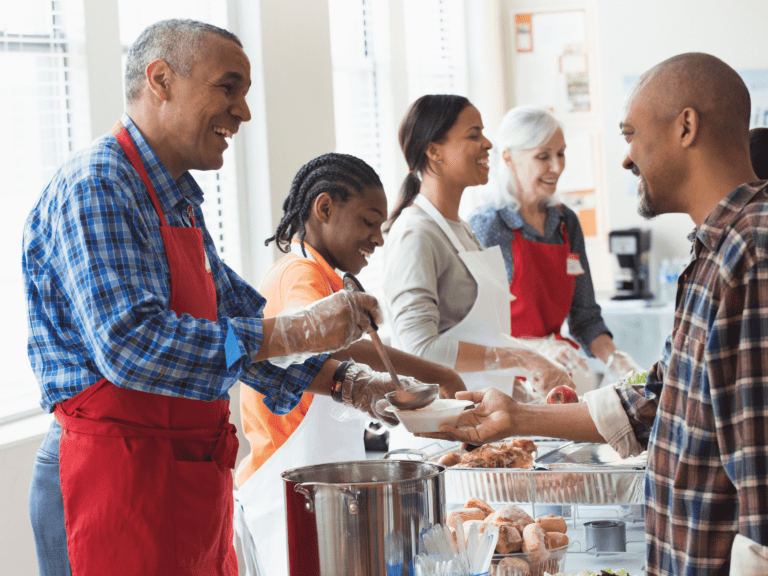Last updated: November 21, 2024
Looking for community events ideas to foster stronger community connections?
This guide offers 6 community event ideas to bring people together. You’ll discover:
- Innovative gatherings
- Easy-to-execute plans
- Time-efficient agendas
- Relationship-building strategies
From neighborhood meet-ups to game nights, these events are designed to create meaningful interactions and strengthen community bonds.
Read this article to see how you can make your local connections thrive.
Why you should listen to me: My name is Nick Gray, and I’m the best–selling author of the party handbook The 2-Hour Cocktail Party. I’ve hosted hundreds of parties all over the world. After making it a habit, I can easily host a gathering and make new friends with no sweat. I’ve been featured in The Wall Street Journal, The New York Times, and New York Magazine once called me a host of “culturally significant” parties.Neighborhood Meet and Greet
A Neighborhood Meet and Greet is a casual outdoor gathering designed to help neighbors connect and build a friendlier community.
This community event breaks down barriers between neighbors who might not normally interact.
- Pick a Central Location: Select an easily accessible spot, like a local park or community center, where everyone feels comfortable gathering.
- Set Up Clear Signage: Use handwritten, eye-catching signs to help direct people to the event area, making it easy for guests to find their way.
- Provide Name Tags: Hand out name tags and markers at the entrance. Make sure guests write their first names in large, legible letters so others can easily read them during conversations.
- Start with an Icebreaker: Kick off the event with a simple icebreaker activity to get people talking and help break down any initial awkwardness.
Icebreakers
- Common Ground: Pair up guests and ask them to find three things they have in common within two minutes. Afterward, each pair can share their findings with the group. This activity quickly helps people discover shared interests and sparks natural conversations.
- Time in the Neighborhood: Ask each person to share their name and how long they’ve lived in the neighborhood. Sharing their time in the neighborhood provides insight into their local experience, whether they’re newcomers or long-time residents, which can lead to shared stories and create a sense of community right from the start. It’s a simple way to get conversations flowing without putting anyone on the spot.
Schedule
- 6:00-6:15: Arrival and name tag distribution
- 6:15-6:30: Welcome speech and initial icebreaker
- 6:30-7:00: Mingling time with guided conversation topics
- 7:00-7:15: Group activity (e.g., neighborhood trivia)
- 7:15-7:45: More mingling time
- 7:45-8:00: Closing remarks and future event announcements
Local Business Showcase
This community event brings together local businesses to display their offerings in a fun, interactive setting, supporting the community’s economy and helping residents discover new services.
- Invite Local Businesses: Reach out to a variety of local businesses and offer them the chance to set up booths at your event. This helps create community engagement and gives businesses exposure.
- Select a Suitable Venue: Choose a venue that has enough space to accommodate multiple booths and displays. A park, community center, or large hall could be ideal for this.
- Implement a Passport System: Create a “passport” for visitors to use. As they visit each booth, they receive a stamp or sticker. This encourages interaction and makes visiting every booth more engaging.
- Offer a Prize: Motivate participation by offering a prize for attendees who complete their passports, such as a local gift card or event merchandise.
Schedule
- 6:00-6:15: Businesses set up, attendees arrive
- 6:15-6:30: Welcome speech, explanation of passport system
- 6:30-7:30: Visitors explore booths, collect stamps
- 7:30-7:45: Group icebreaker or networking activity
- 7:45-8:00: Prize drawing for completed passports, closing remarks
Community Potluck
A Community Potluck is a shared meal where each attendee brings a dish to share, naturally bringing people together over food.
Sharing food is a universal way to bond. The casual atmosphere and shared experience of trying different dishes naturally spark conversations.
- Select a Spacious Venue: Pick a location with ample room and enough tables to accommodate everyone comfortably.
- Organize a Dish Sign-Up: Create a sign-up sheet for dishes to ensure a good variety of options. This helps avoid duplicates and adds to the event’s diversity.
- Consider a Fun Theme: Introduce a theme such as “International Cuisines” or “Family Recipes” to make the event more interesting and encourage creativity.
- Use Dish Introductions as an Icebreaker: Have each guest introduce their dish, sharing a story or background behind it. This is a great way to spark conversations and connections.
Schedule
- 6:00-6:15: Arrival and dish setup
- 6:15-6:30: Welcome and icebreaker (e.g., introducing your dish)
- 6:30-7:15: Eating and mingling
- 7:15-7:45: Guided discussion or group activity
- 7:45-8:00: Cleanup and goodbyes
Local Park Cleanup
A Local Park Cleanup brings the community together to tidy up local parks or green areas, making the neighborhood cleaner and greener.
Working side by side on a common goal helps strengthen bonds among participants.
The sense of accomplishment fosters a positive vibe, and the informal atmosphere encourages easy conversations, leading to new friendships.
Plus, the physical activity keeps things lively and engaging!
- Coordinate with Local Authorities: Connect with city officials or park services to identify parks or green spaces that need cleaning.
- Provide Necessary Supplies: Gather essential supplies like trash bags, gloves, and recycling bins for participants.
- Partner with Local Businesses: Reach out to nearby businesses for sponsorships or donations of supplies, like refreshments or cleanup gear. This not only reduces costs but also encourages community involvement and support from local enterprises.
Schedule
- 8:00-8:15: Arrival, supply distribution, and safety briefing
- 8:15-8:30: Icebreaker and team formation
- 8:30-7:30: Cleanup activity
- 7:30-7:45: Reconvene and share accomplishments
- 7:45-8:00: Refreshments and socializing
Community Book Swap
A Community Book Swap is a great way to boost literacy and connect with others who share a love for reading.
When people come together to browse and chat about their favorite books, it creates instant conversation starters.
The laid-back vibe encourages casual interactions, and as folks share recommendations, those light chats can lead to deeper connections.
- Ask Participants to Bring Books: Encourage everyone to bring a selection of books they’re ready to swap.
- Set Up Display Areas by Genre: Organize the space by creating different stations for each book genre, like fiction, non-fiction, mystery, and fantasy.
- Use Name Tags with Favorite Books Listed: Have participants wear name tags that include their name and a favorite book.
- Implement the “Green, Yellow, Red” Conversation Progression: Use a color-coded system for discussions, where “green” means participants are open to chatting about any book, “yellow” indicates they’re willing to talk about specific genres, and “red” signals they’re looking for more focused conversations.
Schedule
- 6:00-6:15: Arrival and book setup
- 6:15-6:30: Welcome and literary icebreaker
- 6:30-7:15: Book browsing and swapping
- 7:15-7:45: Small group book discussions
- 7:45-8:00: Favorite book recommendations and closing
Local History Walk
A Local History Walk is a fun, guided tour that lets you explore the history of your neighborhood or town, helping everyone feel more connected to the community.
As you stroll and learn together, it sparks conversations and builds strong bonds among participants.
The final discussion gives everyone a chance to dive deeper into their shared interests in the area’s heritage!
- Team Up with Local Historians: Collaborate with local historians to design a compelling tour route that highlights significant landmarks and stories in your neighborhood.
- Incorporate Fun Tools: Use eye-catching tools, like a harmonica, to help manage the group and keep everyone’s attention.
- Host a Casual Gathering: Conclude the walk with a relaxed gathering where participants can share their thoughts and experiences. This informal setting encourages deeper discussions and strengthens the connections formed during the tour.
Pro tip: You can also host morning walks. Read more about How to Host a Morning Walk: The Board Walks Case Study here.
Schedule
- 9:00-9:15: Meet-up and introduction
- 9:15-10:30: Guided walk with several stops
- 10:30-11:00: Refreshments and discussion about local history
Intergenerational Game Night
An Intergenerational Game Night invites people of all ages to enjoy board and card games together, fostering connections across generations.
The relaxed atmosphere encourages interaction, allowing different age groups to engage with each other.
Whether in friendly competition or teamwork, players build friendships and strengthen bonds while having fun.
- Select a Range of Games: Choose a mix of board games and card games that cater to various age groups. This ensures everyone finds something they enjoy, from classics like Monopoly to modern favorites like Codenames.
- Create Game Stations: Set up multiple game stations around the venue to encourage movement and exploration.
- Incorporate Icebreakers: Use fun icebreaker activities at the beginning of the event to help break down barriers between age groups. Simple prompts can encourage conversation, making everyone feel more comfortable and engaged right from the start.
Nick’s note: I wrote a separate article about 8 fun ideas if you’re planning to host a cozy game night. Read it here.
Icebreakers
- “Guess the Year” Icebreaker Give each person a card with a year written on it, keeping it secret. Participants mingle and ask yes/no questions about events, pop culture, or technology to guess the year on others’ cards. The game ends after a set time or when most have guessed correctly.
- “Favorite Childhood Game” Sharing Gather in a circle and have each person share their name and favorite childhood game. For lesser-known games, encourage brief explanations of how they were played.
Schedule
- 7:00-7:15: Arrival and game selection
- 7:15-7:30: Welcome and intergenerational icebreaker
- 7:30-8:30: Game rotations (3 x 20-minute rounds)
- 8:30-8:45: Large group game
- 8:45-9:00: Wrap-up and favorite moment sharing
Conclusion
These community event ideas offer a great starting point for bringing people together and strengthening your local bonds.
Here are the main takeaways:
- Use name tags to facilitate easy introductions
- Implement icebreakers to get conversations flowing
- Keep events time-bound to maintain energy
- Use activities that naturally encourage interaction
- Create environments where diverse groups can connect
- Progress from simple to more in-depth conversations
The goal is to create an environment where people feel comfortable, engaged, and connected.
With these ideas and techniques, you’re well on your way to hosting memorable community events that leave a lasting positive impact.
In my book, The 2-Hour Cocktail Party, I provide helpful guidance on how to host a great party for any event. I wrote this book to support anyone interested in meeting new people.
When is your party? Send me an email and I will give you some bonus tips, including a pre-party checklist that you can print out. Plus, I’ll answer any question you have, free of charge. I love talking about parties, and I’m on a mission to help 1000 people host their first party.


